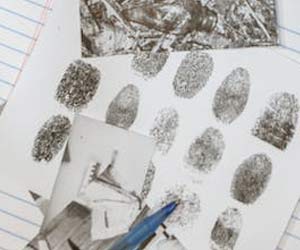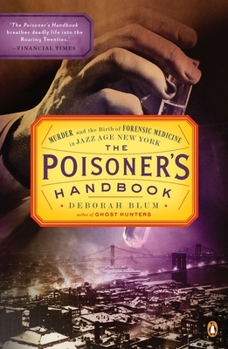The Poisoner's Handbook: Murder and the Birth of Forensic Medicine in Jazz Age New York
Select Format
Select Condition 
Book Overview
Equal parts true crime, twentieth-century history, and science thriller, The Poisoner's Handbook is "a vicious, page-turning story that reads more like Raymond Chandler than Madame Curie." --The New York Observer "The Poisoner's Handbook breathes deadly life into the Roaring Twenties." --Financial Times "Reads like science fiction, complete with suspense, mystery and foolhardy guys in lab coats tipping...
Format:Paperback
Language:English
ISBN:014311882X
ISBN13:9780143118824
Release Date:January 2011
Publisher:Penguin Books
Length:336 Pages
Weight:0.69 lbs.
Dimensions:0.7" x 5.6" x 8.5"
Age Range:18 years and up
Grade Range:Postsecondary and higher
Customer Reviews
4 ratings
The Birth of Forensic Medicine Against a Backdrop of Prohibition
Published by Thriftbooks.com User , 14 years ago
Police work has always included an element of an arms race between criminals trying to outwit authorities and get away with a crime and police trying to prevent this from happening. This battle of wits is especially true in the case of murder. Science in the latter part of the 1800's had exponentially added to the store of chemicals whose use could prove to be fatal to humans. Science was great at finding all sorts of new elements and chemical compounds. The problem was that science was not always good at seeing if these new discoveries were safe around people, and there was no shortage of people who were willing to explore the lethality of these new chemical. It is against this "golden age of poison" that Blum builds her history. Through the dangerous poisons (chloroform, arsenic, mercury, cyanide, radium and wood and grain alcohols) active in the early twentieth century New York City she tells the story of Charles Norris and Alexander Gettler, who are arguably the fathers of the modern Medical Examiner's office and of forensic science. Set against the backdrop of the hubbub of New York City as a growing city, a center of society and money, and as ground zero in the social experiment of Prohibition, Norris works to advance the medical examiner's office from a position of patronage to Tammany Hall to an office integral to the solving of crime and building a knowledge base for civic health information. Norris would be the driving force of change trying to build a modern department built upon science, as well as be a Cassandra warning about the coming dangers of Prohibition in terms of public health as drinkers, cut off from their normal alcohol, would turn to poisonous wood alcohol drinks, despite the government's attempts to render industrial wood alcohols poisonous (denatured). Meanwhile Gettler, the meticulous toxicologist continues experimenting to test and discover new ways to identify and test organs and tissue for the presence of poisons - the better to convict poisoners. Each chapter revolves around cases encountered that involved the particular poison, covering the two decades between 1915 and 1936. A recurring theme of the chapters is how society focused on the triumph of the industrial age, blasting ahead with new chemicals without worry or heed to potential health effects. Cyanide gas would be freely pumped into areas to rid buildings and ships of rats and other pests with little regard to the dangers should the gas seep up pipes to inhabited areas on the floors above, or the danger to sailors in fumigated ships that had not had the gas fully ventilated from below decks. Arsenic, mercury compounds, cyanide compounds and thallium were all generously available for purchase as rat poison, cleaning agents and for, often dubious, medicinal purposes. But what could be a benefit to society could also very quickly become deadly when used incorrectly or illicitly. Glow in the dark radium watch faces were a boon that came from necessity in Wor
A Genuine, But Highly Entertaining, Poisoner's Handbook
Published by Thriftbooks.com User , 14 years ago
I love reading about famous crimes, medical oddities, and cases solved by forensics. This book has them all, and is every bit as entertainingly well-written as my old favorite, THE MEDICAL DETECTIVES. by Berton Roueche. Better yet, the title, THE POISONER'S HANDBOOK, is not just hyperbole. In describing famous New York City crimes committed with poison, the author discusses the chemical makeup, toxic effects, and early-20th-century sources of (1) chloroform, (2) methyl alcohol, (3) cyanide, (4) arsenic, (5) mercury, (6) carbon monoxide, (7) radium, and (8) thallium. In reading this book, you will probably find that there is a lot you thought you knew but didn't really know about well-known poisons frequently encountered in mystery novels and television shows. Did you think that fast-acting cyanide delivers a "one whiff, you're done" death? Think again! Did you think that only Skid Row bums drank wood alcohol during Prohibition? Not so! Did you know that Marie Curie died of radiation poisoning? Probably, but did you know exactly how radium works in the body to produce aplastic anemia and death? In reading this book, you will also learn about pioneering forensics efforts that required the grinding up of large samples of brain and organ tissue prior to laboratory testing. (In the early 20th century, testing was done with "wet" chemistry; today it is done with "dry" chemistry that only requires smears for testing.) The testing itself required many time-consuming steps and tricky procedures. Some of the testing involved tissue samples that were retained in room-temperature containers for weeks and months. The book also tells the story of three great pioneers in forensics science--NYC medical examiner Charles Norris, his chief chemist, Alexander Gettler, and New Jersey medical examiner Harrison Martland. Norton and Gettler lobbied tirelessly against Prohibition, which caused countless deaths from bad booze (renatured industrial alcohol), and against other toxic commercial products sold for hair removal, better-looking skin, and generally improved health. Martland did important research into the effects of radium on factory workers who painted radium watch dials, and also lobbied against the sale of radium-laced health elixirs, such as Radithor. Some of these toxic products actually worked--until they succeeded in poisoning the user. Although the book is an easy read, it is well-researched, and includes footnotes describing the author's sources. (My advance review copy did not include footnote numbers within the text, but presumably the numbers will appear in the final printed book.) The book also includes a useful bibliography of scholarly works on forensic toxicology.
"This is a Poison. Warn Everyone..."
Published by Thriftbooks.com User , 14 years ago
Alexander Gettler "positively hated the idea that some poisoner off the street could outwit him." No other city in the United States in the early 1900's had a toxicology lab. Gettler was hired to design the lab and invent the methods for analyzing poisons. He was the perfect man for the job. "If research methods didn't exist, he would develop them himself. If a new poison or drug came on the market, he went off to a butcher shop, just around the corner from his Brooklyn home, and bought three pounds of liver." Poisoners during this time were hard to catch and even harder to convict in a court of law. The science of toxicology was so new that it seemed to many jurors to be nothing more than conjecture so a person guilty of poisoning could easily walk free. Gettler worked tirelessly at his work and his paper, "The Toxicology of Cyanide," was so thorough and accurate that it was referenced into the 21st century. Deborah Blum writes thoroughly about a fascinating subject. Her writing remains interesting while still including the more technical chemistry involved in toxicology. Blum recounts some of the more notorious cases like Typhoid Mary and introduces us to America's Lucretia Borgia, Mary Fanny Creighton, who continued to haunt Gettler for twelve years after her 'not guilty' verdict in the murder of her brother and mother-in-law. Or Eben M. Byers, a fifty-two year old millionaire, industrialist, athlete and social elitist, who enjoyed his health drink, Radithor while his bones were mysteriously splintering, his skin was yellowing and his kidneys failing. He drank over a thousand bottles of his health drink never imagining that the radium-based drink was his killer. "This is a poison. Warn Everyone." Gettler's message to doctors after realizing wood alcohol was responsible for the severe weakness and abdominal pains, vomiting, blindness, heart failure and death. Used as a substitute during Prohibition, wood alcohol often caused blindness and death. Wood Alcohol, radium, arsenic, mercury, carbon monoxide, ethyl alcolhol... it's a wonder anyone lived a long life with these poisons freely available and often freely dispensed. This is a very captivating book for the reader with an interest in science and history.
Fascinating forensics history book - sort of a "CSI NYC, the Early Years"
Published by Thriftbooks.com User , 14 years ago
Until reading this book I had never given any thought to how forensic medicine started. I had no idea that in the early 1900's our country was not as advanced as European countries in it's efforts to use science to make definitive determinations of the causes of deaths. The author begins the book by explaining that medical examiners were elected in NYC at the turn of the century, and the Tammany Hall system resulted in incompetent and corrupt medical examiners holding the office. A reform movement resulted in the establishment of an ME's office that not only operated respectably, but that undertook cutting edge research in order to come up with methods to determine if people had been poisoned. The book is arranged in chapters for the major types of poisoning of the early 1900's. This book does NOT read like a textbook. The author provides you with the political and social picture, and also the personalities of the various doctors who developed the tests to determine poisons as well as the vicitms and the perpetrators. One historical point I had been totally unware of was that doctors pushed for repeal of Prohibition. During prohibition there was a dramatic increase in the number of people dying due to deadly concoctions sold by bootleggers. In addition, the U.S. government required manufacturers to add some horrific chemicals to products that had alcohol in them but were not meant for drinking in an attempt to prevent people from drinking them. Alcoholics drank those products anyway, with terrrible consequences. One of the saddest chapters was about radium. In WW1 soldiers needed watch faces that could be read in dim light or darkness. It was discovered that radium glowed and was good for this purpose. Women in a factory in New Jersey used their mouths to wet paintbrushes they dipped into radium for painting those numbers. In addition, the factory air had a dangerously high level of radium in it. As a result, these women had heavy exposure to radium. Radiation poisoning sickened and ultimately killed them and some sued and won a settlement from their employer. There were also companies selling water containing radium as a health drink. Sadly, it wasn't until a well known and wealthy NYC man died (from consumption of radium drinks) that any effort was made to outlaw products containing this deadly substance and force companies to protect their workers from it. The author obviously did a lot of research for this book, and did an excellent job in providing simple but full explanations of the science. I don't give a lot of books 5 stars, but this one absolutely deserves it.
The Poisoner's Handbook: Murder and the Birth of Forensic Medicine in Jazz Age New York Mentions in Our Blog

11 True Crime Books Offering a Unique Historical Perspective
Published by Ashly Moore Sheldon • October 11, 2022
We love books that educate while also entertaining us. Historical true crime offers a gripping story enriched with a bit of a history lesson. Read on for eleven true crime books shining a light on a particular moment in history.






